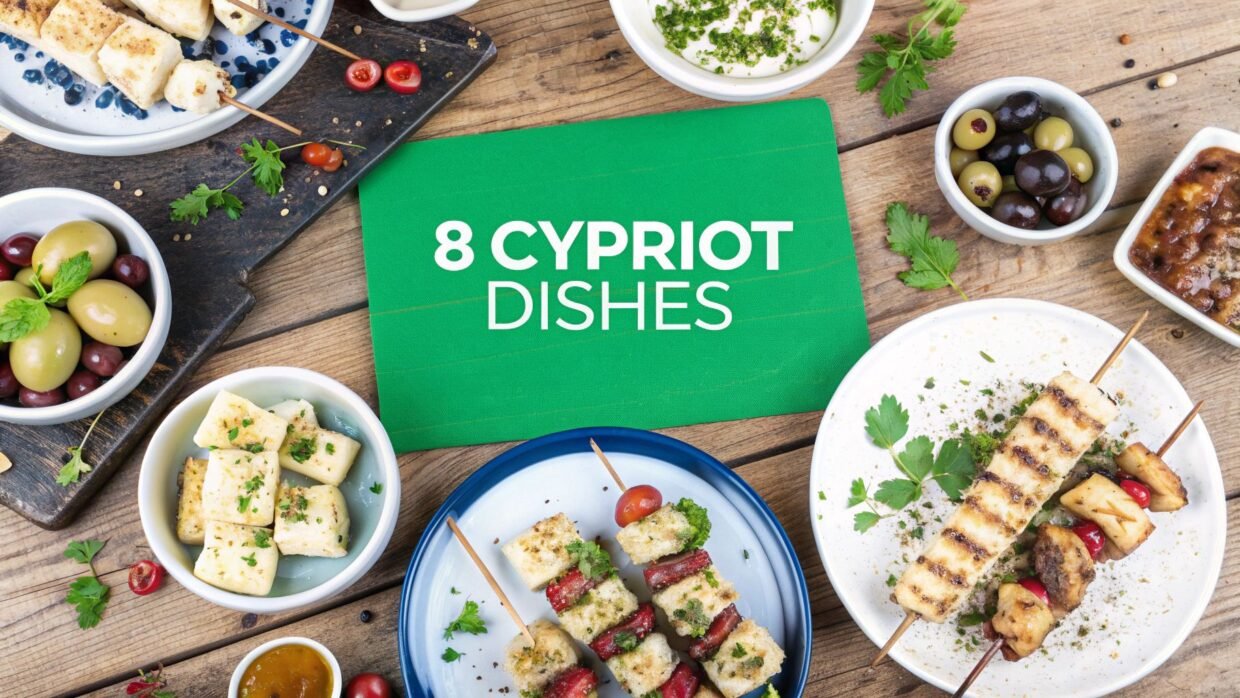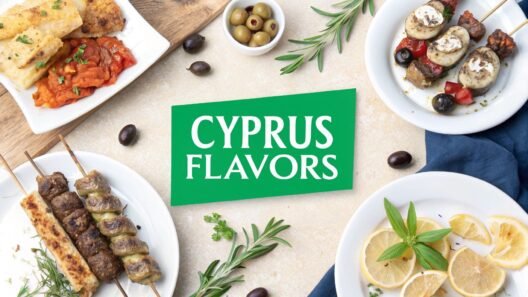Welcome to Cyprus, an island where every meal tells a story steeped in history and hospitality. While famous for its stunning coastlines and ancient ruins, the true heart of the island lies in its rich culinary traditions. To truly experience Cyprus is to taste it, and understanding the local cuisine is key to unlocking an authentic travel experience. This guide moves beyond the generic tourist fare, taking you straight into the kitchens of local tavernas to explore the vibrant flavours of typical Cypriot food.
This is not just another food list. We're diving deep into the dishes that define Cypriot culture: from world-renowned cheeses and slow-cooked lamb to the social ritual of a communal feast. For international travellers and food enthusiasts alike, knowing what to order is the first step towards a memorable gastronomic adventure.
We have curated a definitive list of eight essential dishes you must try. Each entry offers a genuine taste of the island's soul, complete with descriptions of their unique character and flavour profiles. Prepare your appetite for a journey through Cyprus's most beloved and delicious offerings.
1. Halloumi (Χαλλούμι)
No exploration of typical Cypriot food would be complete without paying homage to its most famous export: Halloumi. This iconic semi-hard, unripened brined cheese is traditionally crafted from a mixture of goat's and sheep's milk, giving it a distinctive layered texture and a salty, tangy flavour. Its unique characteristic is its high melting point, which allows it to be grilled or fried to perfection without losing its shape, resulting in a beautifully crisp exterior and a satisfyingly squeaky, soft centre.
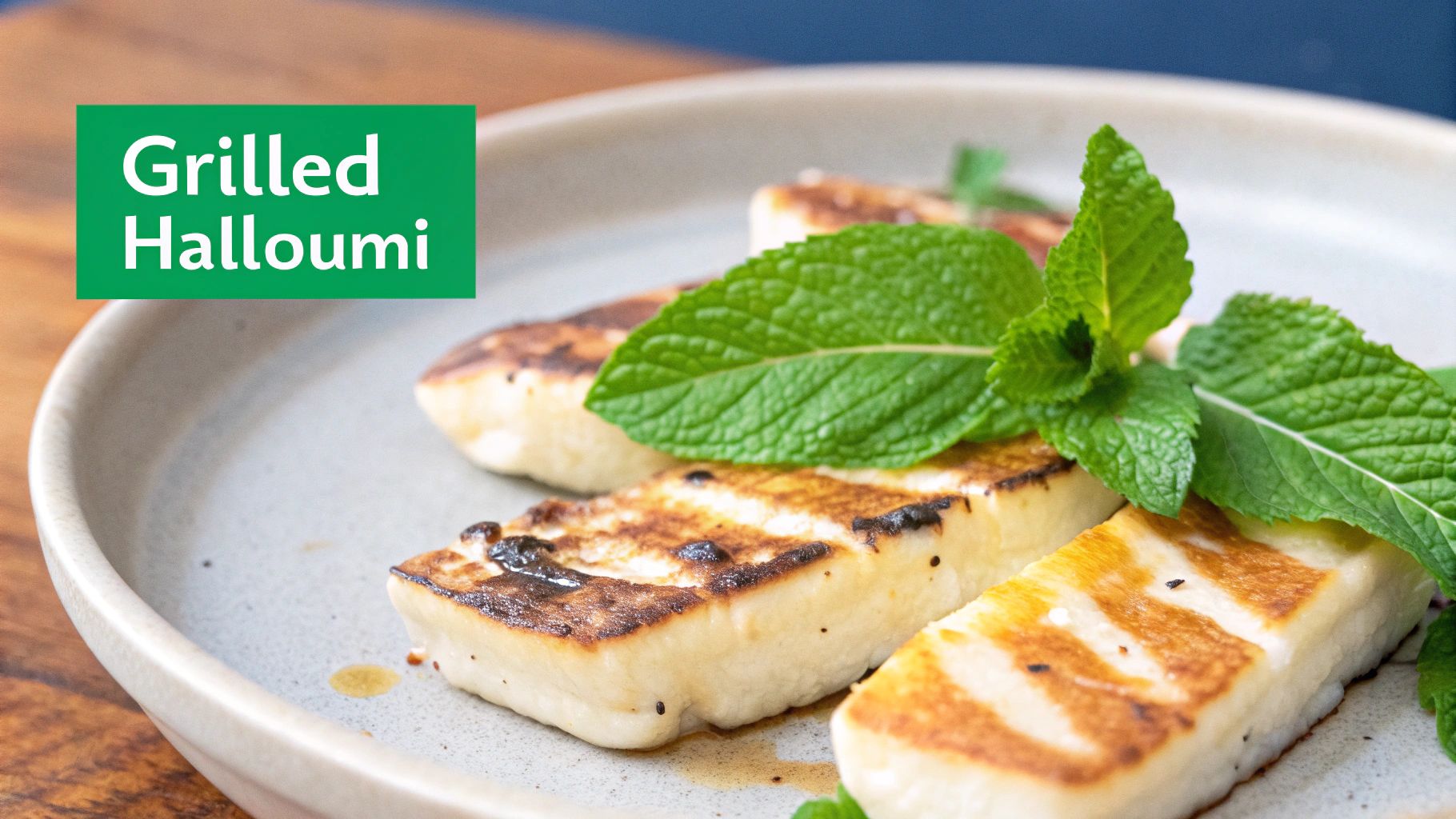
Why It's a Cypriot Staple
Halloumi is deeply woven into the fabric of Cypriot culture and cuisine, with its origins on the island dating back centuries. It holds a Protected Designation of Origin (PDO) status within the EU, meaning authentic Halloumi can only be produced in Cyprus under specific traditional methods. It is an indispensable part of a Cypriot breakfast, often served alongside fresh tomatoes, cucumber, and olives. Its versatility has also seen it become a global star, popularised by chefs like Yotam Ottolenghi and now found everywhere from high-end salads to vegetarian burgers in trendy gastropubs.
How to Best Enjoy Halloumi
While delicious on its own, a few simple techniques can elevate your Halloumi experience. For a truly authentic taste, try pairing slices of grilled or fresh Halloumi with sweet, juicy watermelon during the hot summer months; the combination of salty and sweet is a local favourite.
- Reduce Saltiness: If you find the cheese too salty, soak it in cold water or milk for about 30 minutes before cooking.
- Achieve the Perfect Sear: Grill or fry thick slices on a high, dry heat for just 2-3 minutes per side. You're looking for deep golden-brown marks.
- Serve Immediately: Halloumi is at its best when served hot, straight from the pan, as it can become tough and rubbery once it cools.
- Creative Pairings: Try it drizzled with honey and sprinkled with sesame seeds, or serve it with a squeeze of fresh lemon juice and a scattering of mint.
As you travel through the island, you'll find this celebrated cheese is a cornerstone of the national diet. For a deeper dive into its history and other essential dishes, you can learn more about Halloumi and other traditional Cypriot food.
2. Souvla (Σούβλα)
More than just a dish, Souvla is a cornerstone of Cypriot social life and a culinary ritual in its own right. It consists of large, bone-in chunks of meat, typically lamb, pork, or chicken, skewered and slow-cooked over a charcoal barbecue known as a ‘foukou’ (φουκού). Unlike the smaller, quicker-cooking souvlaki, Souvla is all about patience. The meat is cooked for a much longer period, allowing it to become incredibly tender and infused with a deep, smoky flavour from the charcoal embers.
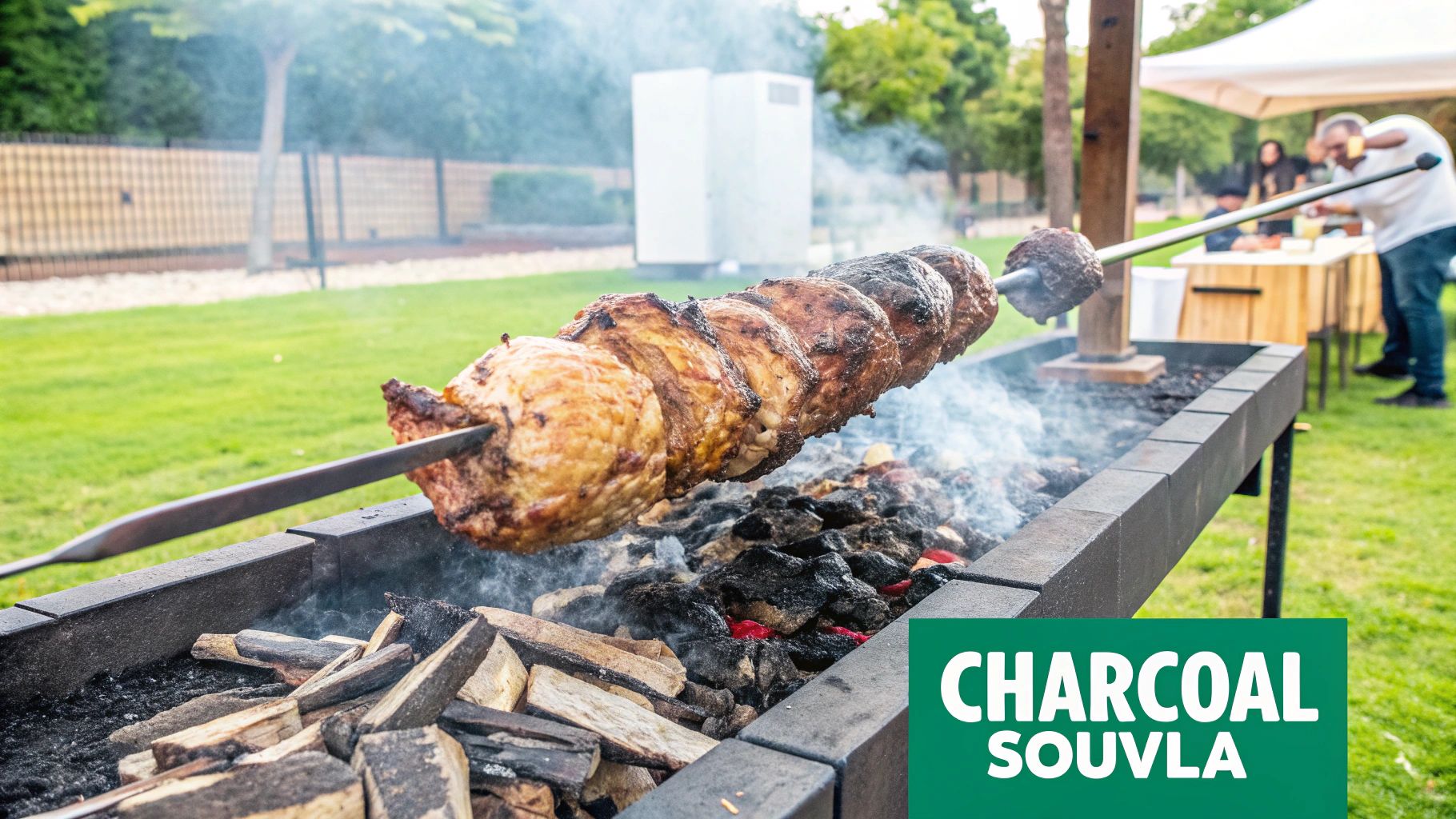
Why It's a Cypriot Staple
Souvla is synonymous with celebration, family, and friendship in Cyprus. It is the centrepiece of nearly every significant social gathering, from Easter Sunday feasts and name day celebrations to casual weekend get-togethers with friends. This slow-cooking tradition encourages people to gather, talk, and relax while the meat gently rotates over the coals. The preparation is kept deliberately simple, seasoned with little more than salt, pepper, and oregano, allowing the high-quality meat and charcoal cooking process to be the stars of the show.
How to Best Enjoy Souvla
The beauty of Souvla lies in its rustic simplicity and the communal experience of sharing it. It is traditionally served straight from the skewer, often with a simple village salad, potatoes, and fresh bread to soak up the juices.
- Choose the Right Cut: For the most succulent results, use shoulder or leg cuts of lamb or pork, as the fat content helps keep the meat moist during the long cooking time.
- Keep Seasoning Simple: Authentic Souvla relies on the flavour of the meat and smoke. A generous coating of salt, black pepper, and perhaps a little oregano is all you need.
- Maintain a Steady Heat: The key is slow and steady cooking. Position the skewer about 30cm above the hot coals and turn it every 15-20 minutes for an even, crispy finish.
- Let It Rest: Before carving, allow the meat to rest for at least 10 minutes. This crucial step lets the juices redistribute, ensuring every piece is tender and flavourful.
- Serve with Lemon: A generous squeeze of fresh lemon juice just before serving cuts through the richness of the meat and brightens the flavours.
This iconic dish is a must-try for anyone seeking authentic typical Cypriot food. To master the art of this beloved barbecue, you can explore more about Souvla and other traditional dishes.
3. Kleftiko (Κλέφτικο)
A true culinary legend of the Cypriot mountains, Kleftiko is a rustic and incredibly tender slow-cooked lamb dish steeped in history. The name translates to 'stolen meat', harking back to a time when bandits, or kleftes, would steal livestock from villages. To avoid being caught, they would cook the meat for hours in sealed earth ovens dug into the ground, a method that trapped all the smoke, aromas, and most importantly, the moisture, resulting in exquisitely succulent, fall-off-the-bone lamb.
Why It's a Cypriot Staple
Kleftiko embodies the heart of Cypriot hospitality and traditional village cooking. While the original cooking method is rare, modern clay ovens replicate the process, making it a centrepiece of celebratory feasts and Sunday family lunches. The simple, robust flavours of lamb, lemon, garlic, and oregano permeate the meat during its long, slow bake. This dish is more than just a meal; it's a taste of the island's rebellious history and a testament to the magic of slow cooking, a core principle in the preparation of typical Cypriot food.
How to Best Enjoy Kleftiko
The beauty of Kleftiko lies in its simplicity, but a few local customs enhance the experience. It's traditionally served with soft, fluffy potatoes that have been cooked in the same parcel, absorbing all the delicious meat juices. The theatrical moment of opening the parchment at the table, releasing a fragrant cloud of steam, is part of the tradition.
- Choose the Right Cut: For the most authentic flavour and tenderness, always use bone-in lamb, typically from the shoulder or leg.
- Marinate Generously: For a deeper flavour, allow the lamb to marinate overnight with lemon juice, whole garlic cloves, and dried oregano.
- Embrace the Juices: Don't let the flavourful cooking juices go to waste. Use fresh village bread to mop up every last drop from your plate.
- Perfect Pairings: Serve alongside a simple village salad (horiatiki) of tomatoes, cucumber, and feta to cut through the richness of the meat.
4. Meze (Μεζές)
More than just a meal, the Meze is the quintessential Cypriot dining experience, a culinary journey that embodies the island's spirit of generosity and communal eating. It is not a single dish but a grand succession of small plates, often numbering between 20 and 30, that flow from the kitchen in a carefully orchestrated sequence. A typical meze unfolds over several hours, beginning with fresh salads, olives, and an array of dips like tahini and tzatziki, before moving on to grilled vegetables, cheeses like Halloumi, and then the main event: a variety of meat or fish dishes, culminating in fresh fruit or a simple dessert.
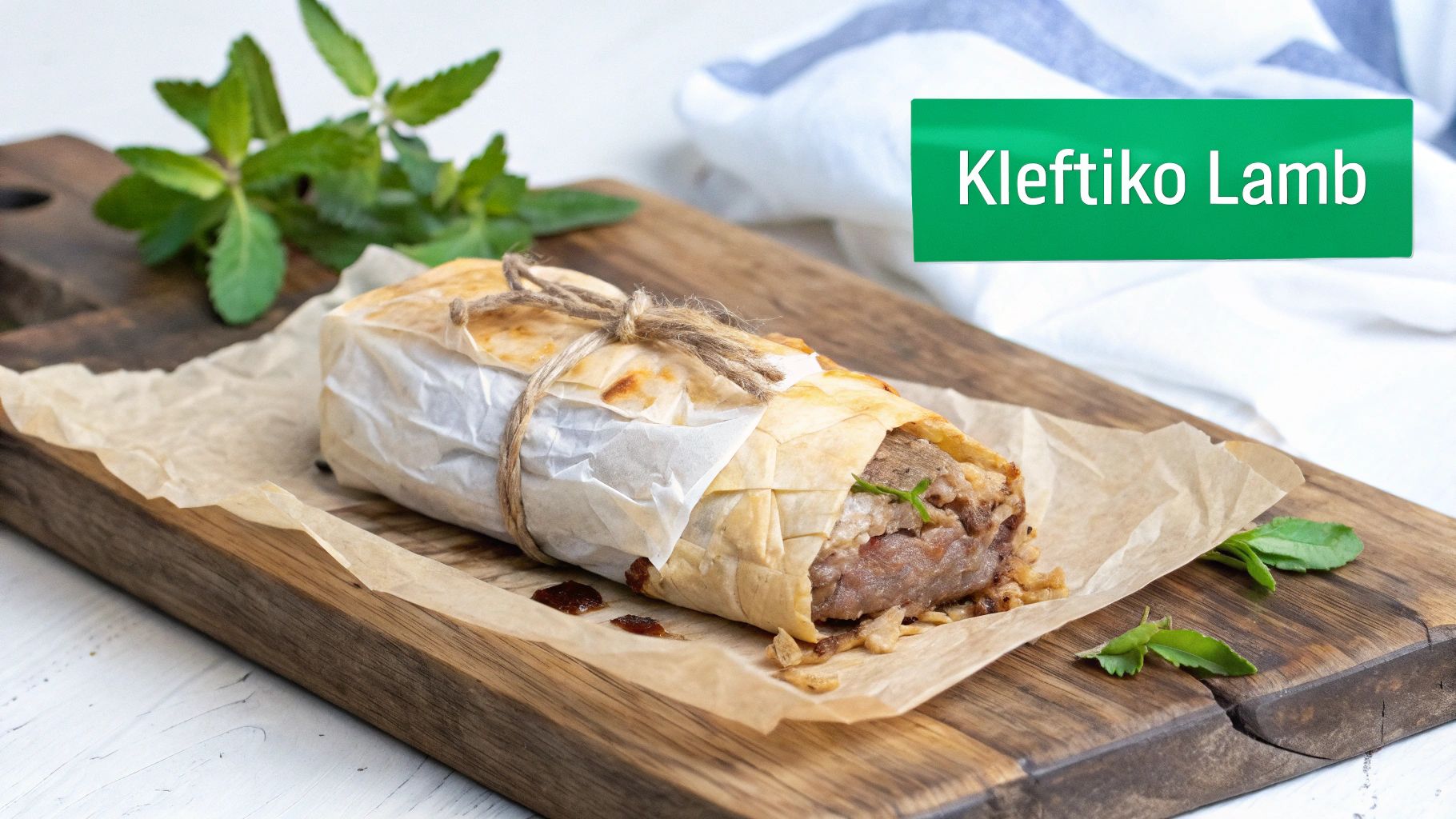
Why It's a Cypriot Staple
The Meze is the heart of Cypriot hospitality. It’s designed for sharing, conversation, and savouring time with family and friends, making it the go-to choice for any social gathering, from casual dinners to grand celebrations. This tradition of offering an abundance of small dishes allows guests to sample the full breadth of typical Cypriot food in one sitting. You will find dedicated meat mezes (psaromezes) in mountain villages like Omodos and fantastic fish mezes (psaromezes) in coastal tavernas such as Vassos Fish Harbour in Agia Napa, each showcasing the best of local produce.
How to Best Enjoy a Meze
To fully appreciate a Meze, one must arrive with a hearty appetite and a relaxed mindset. The experience is a marathon, not a sprint, and is best enjoyed with a group. Most tavernas offer a set price per person, bringing out a seemingly endless parade of their specialities.
- Pace Yourself: This is the golden rule. Do not fill up on the delicious bread and dips at the beginning; there are many more courses to come.
- Be Adventurous: A Meze is the perfect opportunity to try dishes you might not otherwise order. Sample everything, even the unfamiliar items.
- Choose Your Theme: Decide whether you are in the mood for a meat meze or a fish meze before ordering, as most establishments specialise in one or the other.
- Allow Plenty of Time: Plan for the meal to last at least two to three hours. It's a social event designed to be savoured, not rushed.
For anyone wanting to understand the island's culinary soul, indulging in a traditional feast is a must. You can explore more about the traditional food of Cyprus and its famous Meze to prepare for your gastronomic adventure.
5. Sheftalia (Σιεφταλιά)
A true star of the Cypriot barbecue, Sheftalia is a unique, casing-free sausage that captures the essence of homemade comfort food. This delicacy is made from a rich mixture of minced pork or lamb, finely chopped onion, and a generous amount of fresh parsley. What sets Sheftalia apart is its wrapping: instead of a traditional sausage casing, the seasoned meat is enveloped in caul fat, the delicate, lacy membrane from a lamb or pig's stomach. This special wrapping melts away over the charcoal grill, basting the meat and creating an irresistibly crispy, golden-brown exterior while locking in all the juices for a succulent, flavourful centre.
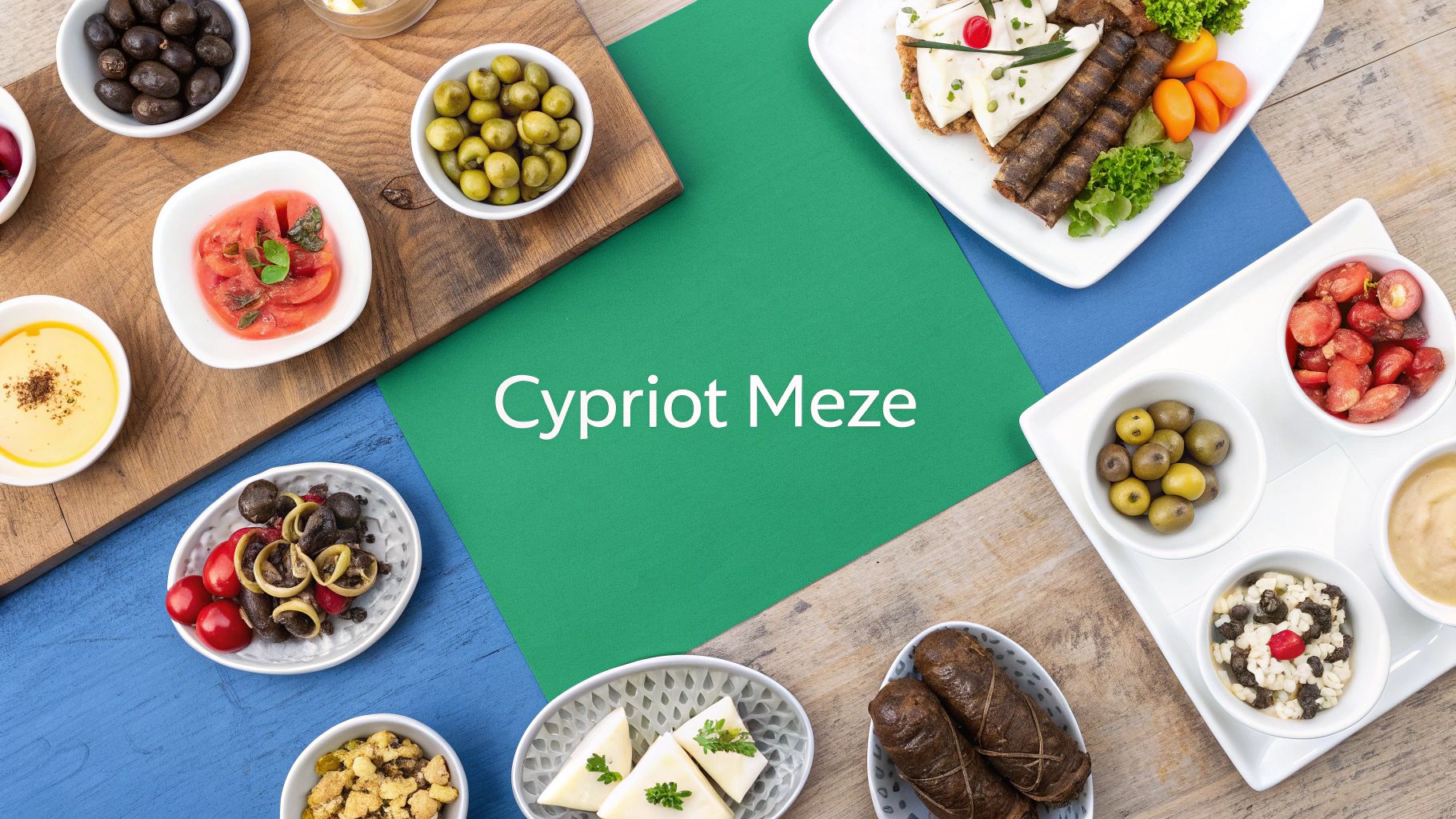
Why It's a Cypriot Staple
Sheftalia is the heart and soul of Cypriot grilling culture, an essential component of any souvla (barbecue) and a fixture at family gatherings, festivals, and celebrations. Its preparation is a cherished tradition, with recipes often passed down through generations. You'll find it sizzling away at traditional souvlaki shops across the island, often served stuffed into a warm pitta bread alongside fresh salad, creating the perfect handheld meal. This beloved dish is a prime example of the rustic, unpretentious, yet incredibly delicious nature of typical Cypriot food.
How to Best Enjoy Sheftalia
Sheftalia is best enjoyed straight from the grill, when the exterior is at its crispiest. A generous squeeze of fresh lemon juice is non-negotiable, as its bright acidity cuts through the richness of the meat perfectly. For an authentic experience, order a "mixed pitta" which includes both souvlaki and sheftalia.
- Look for the Sizzle: Authentic sheftalia should be cooked over charcoal for that signature smoky flavour.
- Don't Overcook: They cook quickly, typically in 8-10 minutes. They are ready when beautifully browned and slightly charred on the outside.
- Classic Accompaniments: Enjoy them with a simple side of chopped tomatoes, cucumber, onions, and parsley.
- Serve Immediately: Like Halloumi, they are best served piping hot to appreciate the contrast between the crisp caul fat and the juicy interior.
Whether enjoyed from a street food vendor in old town Nicosia or at a family Sunday barbecue, Sheftalia offers a mouth-watering taste of Cypriot tradition that is simple, satisfying, and utterly unforgettable.
6. Moussaka (Μουσακάς)
A true heavyweight of Mediterranean comfort food, Moussaka is a rich, baked casserole that holds a cherished place on every Cypriot dining table. While many associate it with Greece, the Cypriot version offers its own delicious twist. It features layers of thinly sliced potatoes, aubergine, and sometimes courgette, which are layered with a savoury minced meat filling, typically lamb or beef. The dish is then crowned with a thick, creamy béchamel sauce and baked until it achieves a perfect golden-brown, bubbling top.
Why It's a Cypriot Staple
Cypriot Moussaka is the ultimate dish for family gatherings and Sunday lunches, embodying the island's spirit of generous, heartfelt cooking. Its key distinction from the Greek version is the inclusion of potatoes, which adds a comforting sturdiness to the dish. The spicing is also subtly different, with cinnamon and allspice often used to gently perfume the meat sauce, creating a flavour profile that is uniquely Cypriot. Found as a daily special in village tavernas and prepared with love in homes across the nation, it’s a cornerstone of the island's culinary identity.
How to Best Enjoy Moussaka
Making a great Moussaka requires patience, but the final result is well worth the effort. Serving it correctly can elevate the entire experience, turning a simple meal into a memorable feast.
- Rest Before Serving: It is crucial to let the Moussaka rest for at least 15-20 minutes after taking it out of the oven. This allows the layers to set, ensuring you can cut clean, beautiful slices.
- A Cypriot Twist: For an authentic local touch, grate some Halloumi cheese into the béchamel sauce before pouring it over the top. This adds an extra savoury, salty kick.
- Healthier Preparation: Instead of frying the vegetable slices, which can absorb a lot of oil, brush them lightly with olive oil and grill or bake them until tender.
- Make Ahead: The flavours of Moussaka deepen and improve overnight. Preparing it a day in advance and simply reheating it can result in an even more delicious dish.
7. Koupepia (Κουπέπια) – Stuffed Vine Leaves
A true labour of love and a centrepiece of celebratory meals, Koupepia are tender vine leaves meticulously stuffed with a savoury filling. Unlike some of their Mediterranean cousins (often known as dolmades), the classic Cypriot version is defined by its use of minced meat, typically pork or beef, combined with rice, finely chopped onions, fresh tomatoes, and a generous amount of herbs like parsley and mint. The small, neat parcels are then layered in a pot and slowly simmered in a broth of water, tomato, and fresh lemon juice until exquisitely tender.
Why It's a Cypriot Staple
Koupepia are the ultimate expression of Cypriot hospitality and family tradition. They are a quintessential part of any significant gathering, from Easter feasts and Christmas dinners to weddings and christenings, where they are often prepared in vast quantities by generations of family members working together. The process of rolling each leaf is a cherished skill passed down through families, making every batch unique. As a key component of a meze platter, they offer a delicious, herb-forward taste of authentic home cooking, representing the heart of typical Cypriot food.
How to Best Enjoy Koupepia
Served warm or at room temperature, Koupepia are a versatile delight. They are perfect as part of a meze spread or as a main course accompanied by a fresh village salad and a dollop of thick Cypriot yoghurt.
- Roll with Care: Don't overfill the vine leaves, as the rice will expand during cooking. Roll them tightly enough to hold their shape but not so tight that they burst.
- Prevent Sticking: Line the bottom of the cooking pot with leftover vine leaves or slices of potato to prevent the Koupepia from catching and burning.
- Keep them Submerged: Place a heatproof plate on top of the Koupepia inside the pot before simmering. This weight keeps them submerged in the cooking liquid and helps them cook evenly.
- Serve Authentically: For a traditional touch, enjoy them warm with a squeeze of fresh lemon juice. They are also often served alongside potatoes that have been cooked in the same pot, absorbing all the delicious flavours.
8. Tava (Ταβάς)
Delving into the heart of Cypriot village cooking, Tava is a rustic and flavourful slow-cooked casserole that embodies the island's culinary soul. Traditionally prepared in a distinctive clay pot of the same name, this dish features tender chunks of lamb or goat meat layered with whole small onions, tomatoes, and aromatic spices like cinnamon and bay leaves. The ingredients are slow-cooked for hours, often in a communal village oven, allowing the meat to become exceptionally tender and the onions to caramelise into sweet perfection.
Why It's a Cypriot Staple
Tava is a cornerstone of typical Cypriot food, particularly celebrated in the Troodos mountains and rural villages. Its origins lie in the communal practice of taking household pots to the local baker to be slow-cooked in the residual heat of the wood-fired ovens. This method not only saved fuel but also brought the community together. Today, Tava remains a cherished dish for Sunday family lunches, religious feast days, and celebrations, representing warmth, tradition, and the comforting taste of a home-cooked meal. Its rich, concentrated sauce and fall-apart meat make it a true delicacy.
How to Best Enjoy Tava
Tava is a deeply satisfying dish on its own, but it's traditionally served with a side of Pourgouri (bulgur pilaf) to soak up the incredible, rich sauce. The key to its authentic flavour is the slow, patient cooking process that melds the simple ingredients into something extraordinary.
- Flavourful Foundation: For the most authentic taste, use bone-in lamb or goat, as the bones release marrow and collagen, enriching the sauce.
- Keep it Layered: Resist the urge to stir the pot during cooking. The distinct layers of meat, onions, and tomatoes are crucial to developing the dish's unique flavour profile.
- Low and Slow: The magic of Tava happens at a low temperature (around 150-160°C). If you don't have a clay pot, a heavy-based Dutch oven is a good substitute.
- Enhance the Richness: A small splash of local red wine can be added to the pot before cooking to introduce an extra layer of depth to the final dish.
Typical Cypriot Foods Comparison Guide
| Dish | Implementation Complexity 🔄 | Resource Requirements ⚡ | Expected Outcomes 📊 | Ideal Use Cases 💡 | Key Advantages ⭐ |
|---|---|---|---|---|---|
| Halloumi (Χαλλούμι) | Low – simple grilling/frying | Moderate – cheese, sometimes fresh mint | Versatile, retains shape, unique texture | Grilling, frying, vegetarian dishes | High melting point, unique texture, versatile |
| Souvla (Σούβλα) | High – slow charcoal cooking, manual turning | High – long skewers, charcoal grill | Tender, smoky, social cooking experience | Large gatherings, festivals | Flavorful smoky meat, social and impressive |
| Kleftiko (Κλέφτικο) | Medium – slow oven cooking in foil/parchment | Moderate – lamb, oven space | Extremely tender, flavorful, moist | Family meals, special occasions | Moisture retention, rich juices, hands-off |
| Meze (Μεζές) | Very High – multiple dishes over hours | High – varied ingredients and prep | Wide variety, social, paced culinary experience | Communal dining, celebrations | Variety of tastes, social and hospitable |
| Sheftalia (Σιεφταλιά) | Medium – grilling sausages on charcoal | Moderate – minced meat, caul fat | Juicy, crispy exterior, traditional street food | Barbecues, street food | Unique casing, juicy meat, easy to eat |
| Moussaka (Μουσακάς) | Medium-High – layered baking with béchamel | Moderate – diverse ingredients | Comfort food, hearty, layered flavors | Family meals, hearty dining | Balanced meal, reheats well, filling |
| Koupepia (Κουπέπια) | High – rolling vine leaves tightly | Moderate – minced meat, vine leaves | Tangy, aromatic, individual portions | Holidays, family gatherings | Elegant presentation, can be frozen |
| Tava (Ταβάς) | Medium – slow cooking in clay pot | Moderate – lamb/goat, clay pot | Tender meat, rich concentrated sauce | Rural family meals, traditional events | One-pot dish, deep flavors, authentic |
Bringing the Taste of Cyprus to Your Table
Our culinary journey across Cyprus has revealed that the island’s food is far more than mere sustenance; it is a vibrant expression of its history, geography, and cultural soul. We have explored the salty, squeaky delight of grilled Halloumi, a true Cypriot icon, and savoured the smoky, slow-cooked perfection of Souvla, the centrepiece of every celebration. Each dish tells a story of tradition, from the rustic, melt-in-the-mouth tenderness of lamb Kleftiko, with its tales of mountain bandits, to the rich, layered comfort of a classic Moussaka.
The essence of Cypriot hospitality is perhaps best captured by the Meze, a seemingly endless parade of small dishes that turns a simple meal into a festive, shared experience. This is where you truly understand the island's philosophy: food is for sharing, for conversation, and for bringing people together. Similarly, hand-rolled treasures like Sheftalia sausages and delicate Koupepia (stuffed vine leaves) demonstrate a commitment to time-honoured techniques passed down through generations, showcasing a deep respect for local ingredients and authentic flavours. The hearty, communal spirit is also baked into dishes like Tava, a comforting stew that embodies the warmth of a Cypriot family kitchen.
Your Next Culinary Steps
Embracing typical Cypriot food is an invitation to slow down and appreciate the craft behind each plate. It’s about understanding the delicate balance of herbs, the importance of patience in slow-cooking, and the joy of a table laden with dishes to be shared.
- Be Adventurous with Meze: When you order a meze, you are placing your trust in the chef. Embrace the surprise and use it as an opportunity to sample dishes you might not have chosen yourself.
- Seek Out Village Tavernas: While city restaurants are excellent, the most authentic culinary experiences are often found in smaller, family-run tavernas in the villages. This is where you will find recipes that have remained unchanged for centuries.
- Try Your Hand at Home: Don't let the experience end with your holiday. Many of these dishes, while requiring patience, use accessible ingredients. Start with making your own Sheftalia or a simple Tava to bring the taste of the Mediterranean into your own home.
Ultimately, to truly know Cyprus is to taste it. The island’s cuisine is a direct line to its heart, a delicious narrative of conquest, trade, and agricultural bounty. Whether you are firing up a barbecue for souvla with friends or enjoying a quiet moment with a slice of moussaka, you are participating in a rich and enduring culinary legacy. We hope this guide has not only made you hungry but also inspired you to dive deeper into the incredible world of Cypriot gastronomy.
Ready to plan your own unforgettable culinary tour of Cyprus? Visit SayCyprus for in-depth local guides, reviews of the best tavernas, and bespoke travel itineraries that place authentic food experiences at the heart of your trip. Let SayCyprus help you discover the hidden gems where you can taste the very best of typical Cypriot food.









